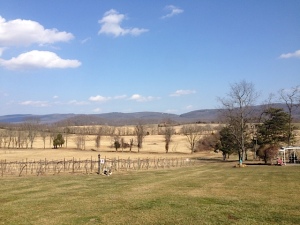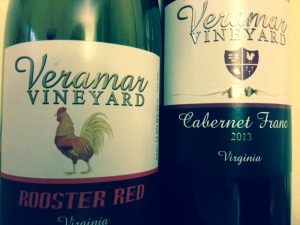A few weeks ago we went to celebrate our 5th anniversary in and around Harper’s Ferry, West Virginia. As history, hiking, and wine fanatics, this area had everything we wanted all in one spot. You may know Harper’s Ferry from the famous uprising of abolitionist John Brown, which would eventually lead to our nation’s civil war. We stayed in a bed and breakfast in nearby Charles Town that was built on George Washington’s first land purchased in the area. In fact, Charles Town was named for his brother. Our first morning we spent in historic Shepherdstown and then crossed the Potomac into Maryland for a visit to Antietam National Battlefield, rendered all the more somber and powerful from an overnight snowfall. And the state of Virginia is home to over 200 wineries, with a long history of vine cultivation, but we will get to that in a minute.
With the unexpected weather we had opted to postpone our hike and winery visits until the next day when things would have melted off a bit. This was more for hike safety than for the winery visit, but nevertheless, 1,200 feet up on Loudoun Heights there was still several inches of snow to be found. After heading back down the Appalachian Trail route across the Shenandoah into downtown Harper’s Ferry, we hopped in the car to visit some of the nearby wineries of Northern Virginia.
A friend of mine who lives in the area recommended Veramar winery in Berryville. In complete contrast to the snowy mountaintops, the sun was shining down on the rolling hills and vineyards of the seemingly endless estate, with the expanse of the Blue Ridge extending in the distance as far as the eye could see. This area of the state’s wine industry is Shenandoah Valley AVA. Vine cultivation in Virginia goes back as far as the original Jamestown colony, and Thomas Jefferson himself was growing the first vinifera vines here at his home in Monticello. For more on that subject, read one of my favorite books, “Thomas Jefferson on Wine,” by John Hailman. On this beautiful day, the owner and family were enjoying the weather as well and it sounds like there will be another generation of winemakers in the family. The scenery here is one you could imagine not looking all that different 250 years ago.
After the tasting we bought a bottle of the Cabernet Franc 2013 and ‘Rooster Red’ blend as well as a few whites we enjoyed, particularly the Seyval Blanc. I am writing this on day two for the bottle of Rooster Red I brought home, so that wine has opened up a bit since and really is showing well on the nose and palate.
The Rooster Red is a red Bordeaux-style non-vintage blend. On the nose are black currant and a seductive smokey oak and baking spices along with distinct soil/earth notes — softer on the palate than yesterday for sure. Some fig in there, and coffee bean. It paired nicely with food yesterday and is standing on its own quite well today. It has a medal from the San Francisco Wine Awards as well as commendations from Decanter’s World Wine Awards and 83 points from Wine Enthusiast.
I also bought a bottle of the 2013 Cabernet Franc. Like the Rooster Red, the oak on this wine and the aromas associated with it are really dialed in and integrated. I don’t think I noticed as much at the winery. Though maybe that was a result of all the visitors that day and us just relieved to finally be tasting after waiting 20 minutes for a bridal shower before us to make room at the tasting bar. I was impressed — these smell like some of the best from the west coast and Europe. It is rated at 87 points on the winery site, though I am unable to find the source. On the palate, this Cabernet Franc is a balanced, elegant wine with very little of the under-ripe or green notes I usually encounter in reds from our part of the country. We enjoyed some warm bread and a gouda as well which you can buy at the tasting bar.
 As we were looking over the options for one more stop in the region’s winery list, the staff suggested their sister winery just 7 miles down the road, Bogati.The Bogaty family runs Veramar, hence the name of their sister winery Bogati. (I am unsure of why the spelling was changed in the winery name – perhaps to be more chic?) When they told us it had a modern, Argentian flare, we decided it was defintely worth a visit. I had yet to come across a winery in this part of the country that did South American wines (or rather, a South American style of Malbec, a French native grape finding much success in Argentina of late.) A quick drive through a gap in the Mountains led us to Bogati. On the outside it looks like a modern art gallery space with some lovely views of its own. But inside it’s all about the wine, and plenty of style. Their wines have a few medals of their own, namingly for their Seyval Blanc, the light Pinot Gris-based wine known as “B-thin,” the “Tango Blu,” and their Malbec. The Malbec is really what I was excited about most though and it was a tasty and promising example. But equally as unexpected and unique as a Virginia Malbec, was their Touriga Nacional. You may know this as the principal grape of Portuguese red wines, and this one completely surprised and delighted me. As much for the uniqueness as the taste. If you’re in the neighborhood, stop by both of these fine wineries – they are each within an hour’s reach of Washington DC.
As we were looking over the options for one more stop in the region’s winery list, the staff suggested their sister winery just 7 miles down the road, Bogati.The Bogaty family runs Veramar, hence the name of their sister winery Bogati. (I am unsure of why the spelling was changed in the winery name – perhaps to be more chic?) When they told us it had a modern, Argentian flare, we decided it was defintely worth a visit. I had yet to come across a winery in this part of the country that did South American wines (or rather, a South American style of Malbec, a French native grape finding much success in Argentina of late.) A quick drive through a gap in the Mountains led us to Bogati. On the outside it looks like a modern art gallery space with some lovely views of its own. But inside it’s all about the wine, and plenty of style. Their wines have a few medals of their own, namingly for their Seyval Blanc, the light Pinot Gris-based wine known as “B-thin,” the “Tango Blu,” and their Malbec. The Malbec is really what I was excited about most though and it was a tasty and promising example. But equally as unexpected and unique as a Virginia Malbec, was their Touriga Nacional. You may know this as the principal grape of Portuguese red wines, and this one completely surprised and delighted me. As much for the uniqueness as the taste. If you’re in the neighborhood, stop by both of these fine wineries – they are each within an hour’s reach of Washington DC.

